warning light Alfa Romeo 4C 2016 Owner handbook (in English)
[x] Cancel search | Manufacturer: ALFA ROMEO, Model Year: 2016, Model line: 4C, Model: Alfa Romeo 4C 2016Pages: 182, PDF Size: 9.49 MB
Page 35 of 182
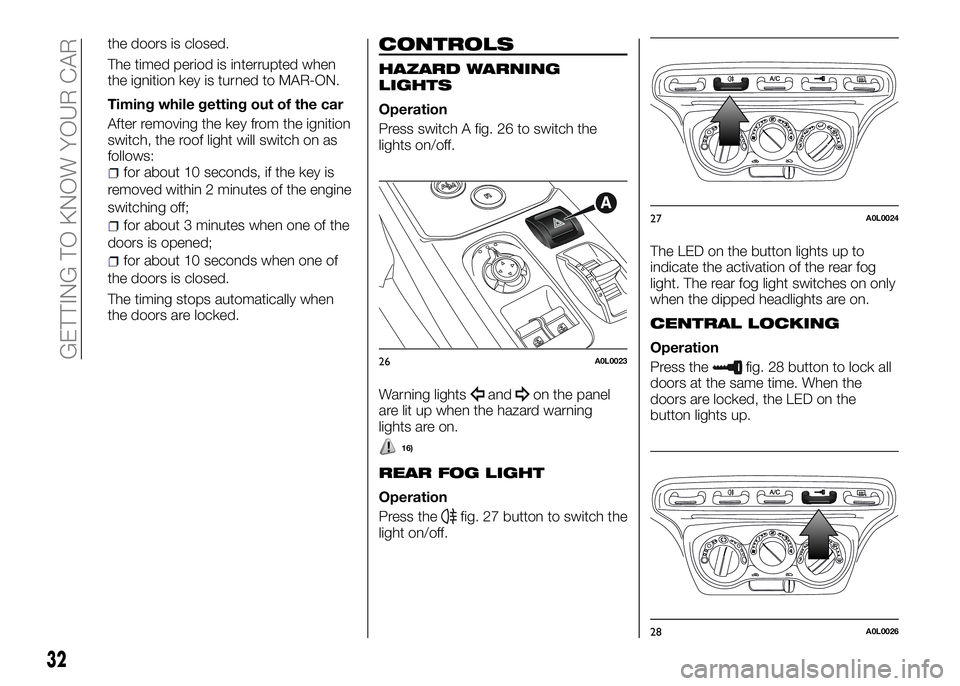
the doors is closed.
The timed period is interrupted when
the ignition key is turned to MAR-ON.
Timing while getting out of the car
After removing the key from the ignition
switch, the roof light will switch on as
follows:
for about 10 seconds, if the key is
removed within 2 minutes of the engine
switching off;
for about 3 minutes when one of the
doors is opened;
for about 10 seconds when one of
the doors is closed.
The timing stops automatically when
the doors are locked.
CONTROLS
HAZARD WARNING
LIGHTS
Operation
Press switch A fig. 26 to switch the
lights on/off.
Warning lights
andon the panel
are lit up when the hazard warning
lights are on.
16)
REAR FOG LIGHT
Operation
Press the
fig. 27 button to switch the
light on/off.The LED on the button lights up to
indicate the activation of the rear fog
light. The rear fog light switches on only
when the dipped headlights are on.
CENTRAL LOCKING
Operation
Press the
fig. 28 button to lock all
doors at the same time. When the
doors are locked, the LED on the
button lights up.26A0L0023
27A0L0024
28A0L0026
32
GETTING TO KNOW YOUR CAR
Page 36 of 182
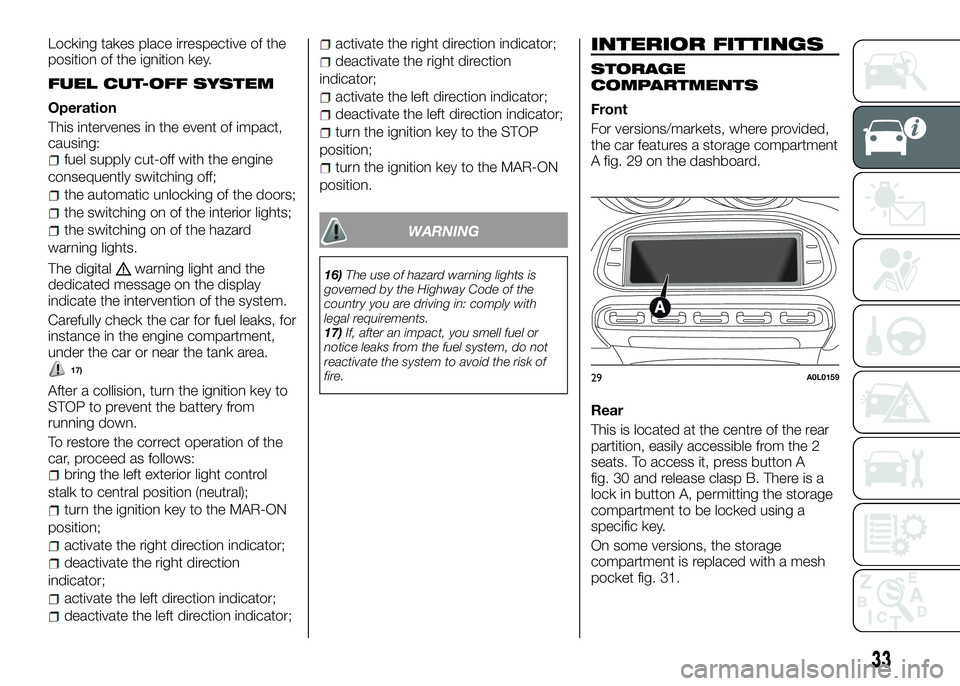
Locking takes place irrespective of the
position of the ignition key.
FUEL CUT-OFF SYSTEM
Operation
This intervenes in the event of impact,
causing:
fuel supply cut-off with the engine
consequently switching off;
the automatic unlocking of the doors;
the switching on of the interior lights;
the switching on of the hazard
warning lights.
The digital
warning light and the
dedicated message on the display
indicate the intervention of the system.
Carefully check the car for fuel leaks, for
instance in the engine compartment,
under the car or near the tank area.
17)
After a collision, turn the ignition key to
STOP to prevent the battery from
running down.
To restore the correct operation of the
car, proceed as follows:
bring the left exterior light control
stalk to central position (neutral);
turn the ignition key to the MAR-ON
position;
activate the right direction indicator;
deactivate the right direction
indicator;
activate the left direction indicator;
deactivate the left direction indicator;
activate the right direction indicator;
deactivate the right direction
indicator;
activate the left direction indicator;
deactivate the left direction indicator;
turn the ignition key to the STOP
position;
turn the ignition key to the MAR-ON
position.
WARNING
16)The use of hazard warning lights is
governed by the Highway Code of the
country you are driving in: comply with
legal requirements.
17)If, after an impact, you smell fuel or
notice leaks from the fuel system, do not
reactivate the system to avoid the risk of
fire.
INTERIOR FITTINGS
STORAGE
COMPARTMENTS
Front
For versions/markets, where provided,
the car features a storage compartment
A fig. 29 on the dashboard.
Rear
This is located at the centre of the rear
partition, easily accessible from the 2
seats. To access it, press button A
fig. 30 and release clasp B. There is a
lock in button A, permitting the storage
compartment to be locked using a
specific key.
On some versions, the storage
compartment is replaced with a mesh
pocket fig. 31.
29A0L0159
33
Page 38 of 182
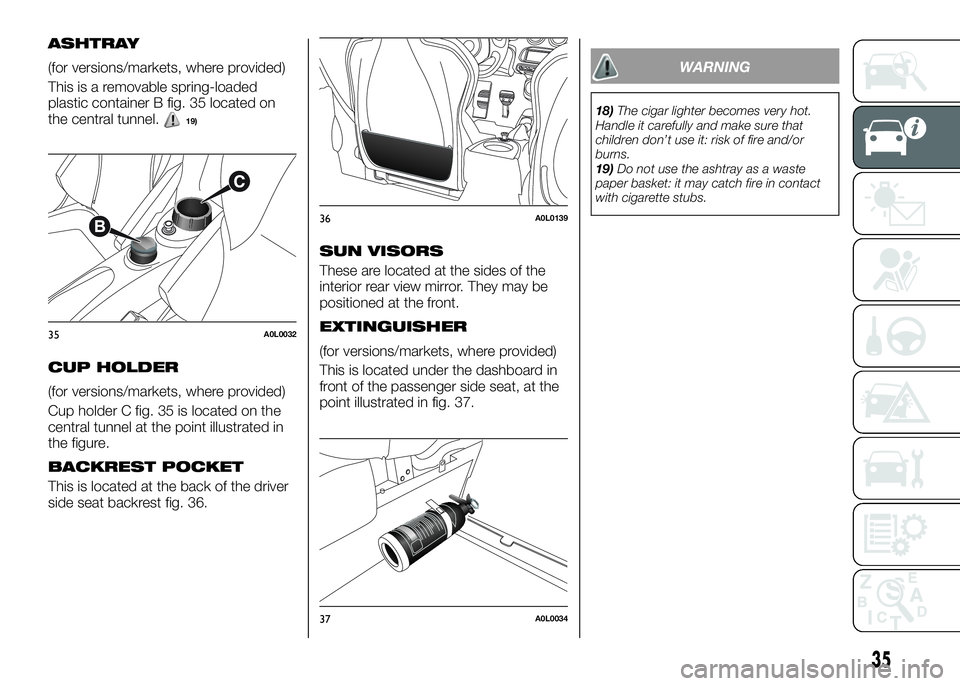
ASHTRAY
(for versions/markets, where provided)
This is a removable spring-loaded
plastic container B fig. 35 located on
the central tunnel.
19)
CUP HOLDER
(for versions/markets, where provided)
Cup holder C fig. 35 is located on the
central tunnel at the point illustrated in
the figure.
BACKREST POCKET
This is located at the back of the driver
side seat backrest fig. 36.
SUN VISORS
These are located at the sides of the
interior rear view mirror. They may be
positioned at the front.
EXTINGUISHER
(for versions/markets, where provided)
This is located under the dashboard in
front of the passenger side seat, at the
point illustrated in fig. 37.
WARNING
18)The cigar lighter becomes very hot.
Handle it carefully and make sure that
children don’t use it: risk of fire and/or
burns.
19)Do not use the ashtray as a waste
paper basket: it may catch fire in contact
with cigarette stubs.
35A0L0032
36A0L0139
37A0L0034
35
Page 42 of 182
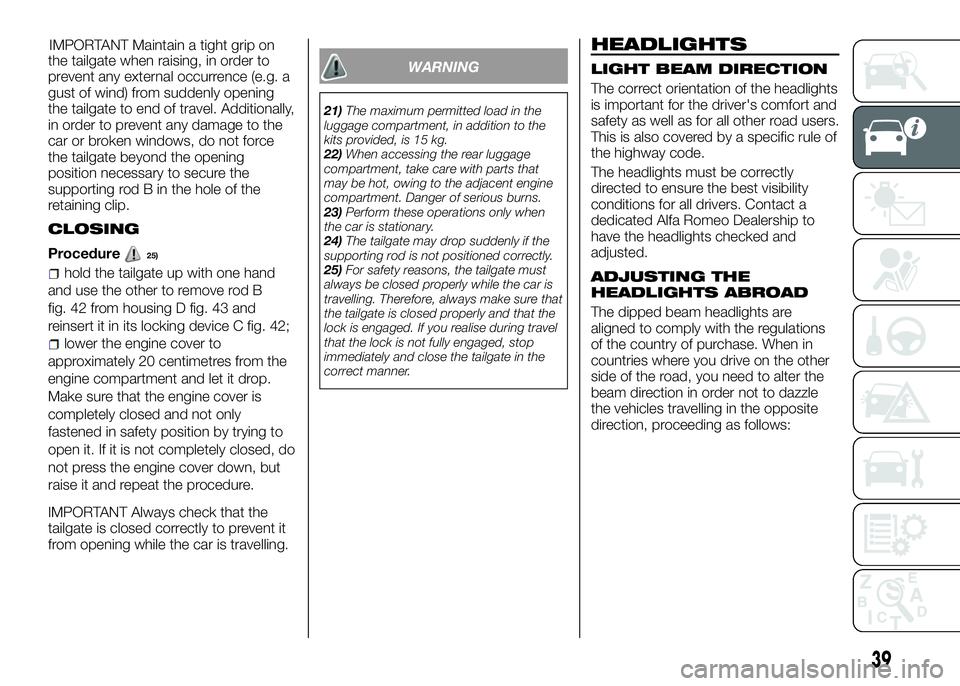
the tailgate when raising, in order to
prevent any external occurrence (e.g. a
gust of wind) from suddenly opening
the tailgate to end of travel. Additionally,
in order to prevent any damage to the
car or broken windows, do not force
the tailgate beyond the opening
position necessary to secure the
supporting rod B in the hole of the
retaining clip.
CLOSING
Procedure25)
hold the tailgate up with one hand
and use the other to remove rod B
fig. 42 from housing D fig. 43 and
reinsert it in its locking device C fig. 42;
lower the engine cover to
approximately 20 centimetres from the
engine compartment and let it drop.
Make sure that the engine cover is
completely closed and not only
fastened in safety position by trying to
open it. If it is not completely closed, do
not press the engine cover down, but
raise it and repeat the procedure.
IMPORTANT Always check that the
tailgate is closed correctly to prevent it
from opening while the car is travelling.
WARNING
21)The maximum permitted load in the
luggage compartment, in addition to the
kits provided, is 15 kg.
22)When accessing the rear luggage
compartment, take care with parts that
may be hot, owing to the adjacent engine
compartment. Danger of serious burns.
23)Perform these operations only when
the car is stationary.
24)The tailgate may drop suddenly if the
supporting rod is not positioned correctly.
25)For safety reasons, the tailgate must
always be closed properly while the car is
travelling. Therefore, always make sure that
the tailgate is closed properly and that the
lock is engaged. If you realise during travel
that the lock is not fully engaged, stop
immediately and close the tailgate in the
correct manner.
HEADLIGHTS
LIGHT BEAM DIRECTION
The correct orientation of the headlights
is important for the driver's comfort and
safety as well as for all other road users.
This is also covered by a specific rule of
the highway code.
The headlights must be correctly
directed to ensure the best visibility
conditions for all drivers. Contact a
dedicated Alfa Romeo Dealership to
have the headlights checked and
adjusted.
ADJUSTING THE
HEADLIGHTS ABROAD
The dipped beam headlights are
aligned to comply with the regulations
of the country of purchase. When in
countries where you drive on the other
side of the road, you need to alter the
beam direction in order not to dazzle
the vehicles travelling in the opposite
direction, proceeding as follows:
39
IMPORTANT Maintain a tight grip on
Page 44 of 182
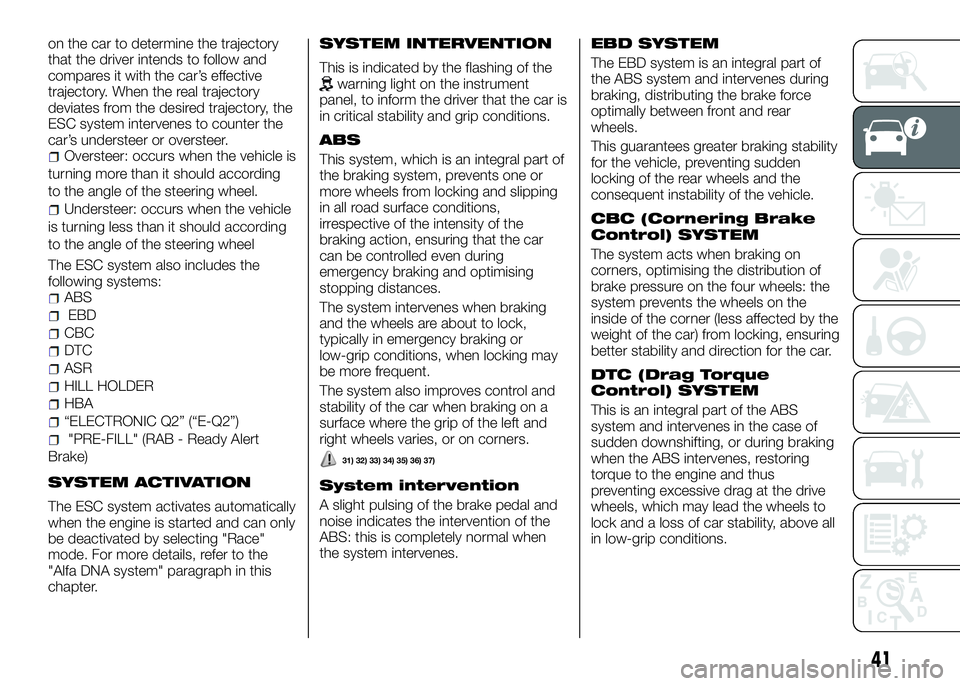
on the car to determine the trajectory
that the driver intends to follow and
compares it with the car’s effective
trajectory. When the real trajectory
deviates from the desired trajectory, the
ESC system intervenes to counter the
car’s understeer or oversteer.
Oversteer: occurs when the vehicle is
turning more than it should according
to the angle of the steering wheel.
Understeer: occurs when the vehicle
is turning less than it should according
to the angle of the steering wheel
The ESC system also includes the
following systems:
ABS
EBD
CBC
DTC
ASR
HILL HOLDER
HBA
“ELECTRONIC Q2” (“E-Q2”)
"PRE-FILL" (RAB - Ready Alert
Brake)
SYSTEM ACTIVATION
The ESC system activates automatically
when the engine is started and can only
be deactivated by selecting "Race"
mode. For more details, refer to the
"Alfa DNA system" paragraph in this
chapter.
SYSTEM INTERVENTION
This is indicated by the flashing of thewarning light on the instrument
panel, to inform the driver that the car is
in critical stability and grip conditions.
ABS
This system, which is an integral part of
the braking system, prevents one or
more wheels from locking and slipping
in all road surface conditions,
irrespective of the intensity of the
braking action, ensuring that the car
can be controlled even during
emergency braking and optimising
stopping distances.
The system intervenes when braking
and the wheels are about to lock,
typically in emergency braking or
low-grip conditions, when locking may
be more frequent.
The system also improves control and
stability of the car when braking on a
surface where the grip of the left and
right wheels varies, or on corners.
31) 32) 33) 34) 35) 36) 37)
System intervention
A slight pulsing of the brake pedal and
noise indicates the intervention of the
ABS: this is completely normal when
the system intervenes.
EBD SYSTEM
The EBD system is an integral part of
the ABS system and intervenes during
braking, distributing the brake force
optimally between front and rear
wheels.
This guarantees greater braking stability
for the vehicle, preventing sudden
locking of the rear wheels and the
consequent instability of the vehicle.
CBC (Cornering Brake
Control) SYSTEM
The system acts when braking on
corners, optimising the distribution of
brake pressure on the four wheels: the
system prevents the wheels on the
inside of the corner (less affected by the
weight of the car) from locking, ensuring
better stability and direction for the car.
DTC (Drag Torque
Control) SYSTEM
This is an integral part of the ABS
system and intervenes in the case of
sudden downshifting, or during braking
when the ABS intervenes, restoring
torque to the engine and thus
preventing excessive drag at the drive
wheels, which may lead the wheels to
lock and a loss of car stability, above all
in low-grip conditions.
41
Page 45 of 182
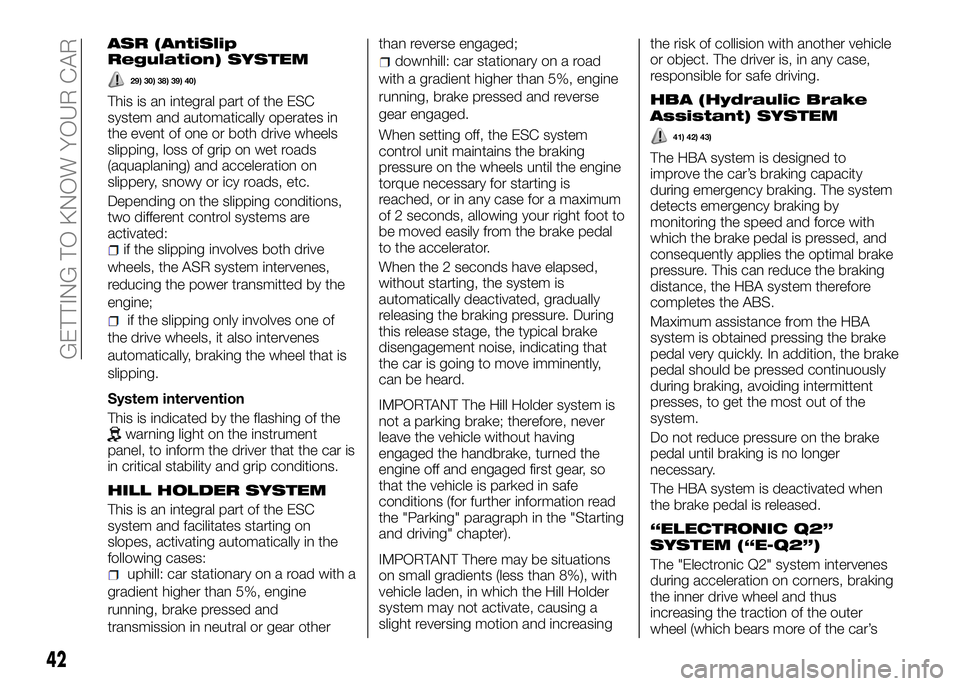
ASR (AntiSlip
Regulation) SYSTEM
29) 30) 38) 39) 40)
This is an integral part of the ESC
system and automatically operates in
the event of one or both drive wheels
slipping, loss of grip on wet roads
(aquaplaning) and acceleration on
slippery, snowy or icy roads, etc.
Depending on the slipping conditions,
two different control systems are
activated:
if the slipping involves both drive
wheels, the ASR system intervenes,
reducing the power transmitted by the
engine;
if the slipping only involves one of
the drive wheels, it also intervenes
automatically, braking the wheel that is
slipping.
System intervention
This is indicated by the flashing of the
warning light on the instrument
panel, to inform the driver that the car is
in critical stability and grip conditions.
HILL HOLDER SYSTEM
This is an integral part of the ESC
system and facilitates starting on
slopes, activating automatically in the
following cases:
uphill: car stationary on a road with a
gradient higher than 5%, engine
running, brake pressed and
transmission in neutral or gear otherthan reverse engaged;
downhill: car stationary on a road
with a gradient higher than 5%, engine
running, brake pressed and reverse
gear engaged.
When setting off, the ESC system
control unit maintains the braking
pressure on the wheels until the engine
torque necessary for starting is
reached, or in any case for a maximum
of 2 seconds, allowing your right foot to
be moved easily from the brake pedal
to the accelerator.
When the 2 seconds have elapsed,
without starting, the system is
automatically deactivated, gradually
releasing the braking pressure. During
this release stage, the typical brake
disengagement noise, indicating that
the car is going to move imminently,
can be heard.
IMPORTANT The Hill Holder system is
not a parking brake; therefore, never
leave the vehicle without having
engaged the handbrake, turned the
engine off and engaged first gear, so
that the vehicle is parked in safe
conditions (for further information read
the "Parking" paragraph in the "Starting
and driving" chapter).
IMPORTANT There may be situations
on small gradients (less than 8%), with
vehicle laden, in which the Hill Holder
system may not activate, causing a
slight reversing motion and increasingthe risk of collision with another vehicle
or object. The driver is, in any case,
responsible for safe driving.
HBA (Hydraulic Brake
Assistant) SYSTEM
41) 42) 43)
The HBA system is designed to
improve the car’s braking capacity
during emergency braking. The system
detects emergency braking by
monitoring the speed and force with
which the brake pedal is pressed, and
consequently applies the optimal brake
pressure. This can reduce the braking
distance, the HBA system therefore
completes the ABS.
Maximum assistance from the HBA
system is obtained pressing the brake
pedal very quickly. In addition, the brake
pedal should be pressed continuously
during braking, avoiding intermittent
presses, to get the most out of the
system.
Do not reduce pressure on the brake
pedal until braking is no longer
necessary.
The HBA system is deactivated when
the brake pedal is released.
“ELECTRONIC Q2”
SYSTEM (“E-Q2”)
The "Electronic Q2" system intervenes
during acceleration on corners, braking
the inner drive wheel and thus
increasing the traction of the outer
wheel (which bears more of the car’s
42
GETTING TO KNOW YOUR CAR
Page 49 of 182
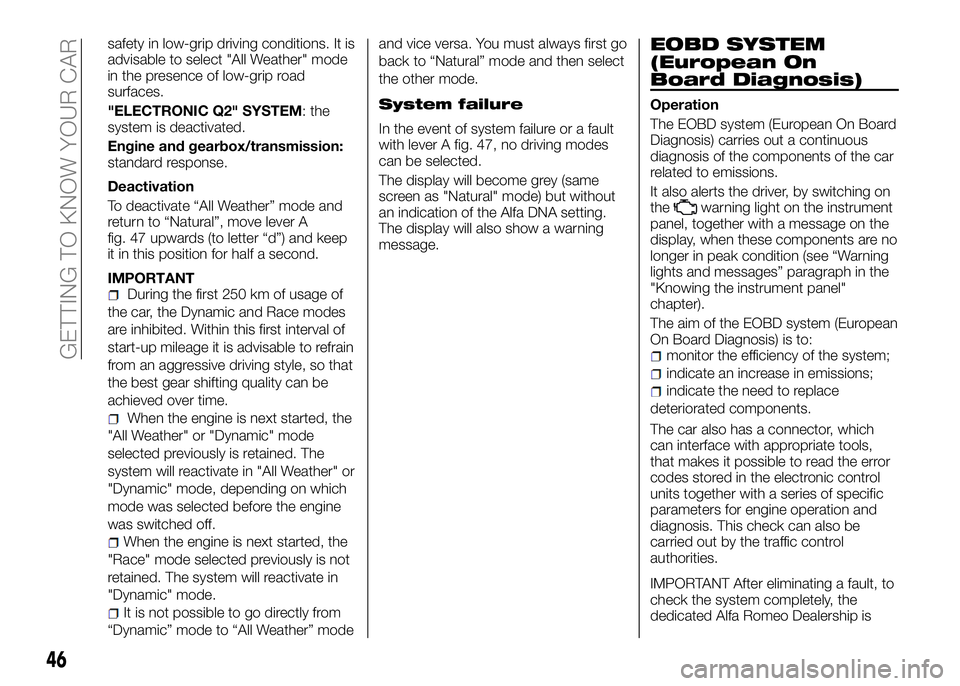
safety in low-grip driving conditions. It is
advisable to select "All Weather" mode
in the presence of low-grip road
surfaces.
"ELECTRONIC Q2" SYSTEM: the
system is deactivated.
Engine and gearbox/transmission:
standard response.
Deactivation
To deactivate “All Weather” mode and
return to “Natural”, move lever A
fig. 47 upwards (to letter “d”) and keep
it in this position for half a second.
IMPORTANT
During the first 250 km of usage of
the car, the Dynamic and Race modes
are inhibited. Within this first interval of
start-up mileage it is advisable to refrain
from an aggressive driving style, so that
the best gear shifting quality can be
achieved over time.
When the engine is next started, the
"All Weather" or "Dynamic" mode
selected previously is retained. The
system will reactivate in "All Weather" or
"Dynamic" mode, depending on which
mode was selected before the engine
was switched off.
When the engine is next started, the
"Race" mode selected previously is not
retained. The system will reactivate in
"Dynamic" mode.
It is not possible to go directly from
“Dynamic” mode to “All Weather” modeand vice versa. You must always first go
back to “Natural” mode and then select
the other mode.
System failure
In the event of system failure or a fault
with lever A fig. 47, no driving modes
can be selected.
The display will become grey (same
screen as "Natural" mode) but without
an indication of the Alfa DNA setting.
The display will also show a warning
message.
EOBD SYSTEM
(European On
Board Diagnosis)
Operation
The EOBD system (European On Board
Diagnosis) carries out a continuous
diagnosis of the components of the car
related to emissions.
It also alerts the driver, by switching on
the
warning light on the instrument
panel, together with a message on the
display, when these components are no
longer in peak condition (see “Warning
lights and messages” paragraph in the
"Knowing the instrument panel"
chapter).
The aim of the EOBD system (European
On Board Diagnosis) is to:
monitor the efficiency of the system;
indicate an increase in emissions;
indicate the need to replace
deteriorated components.
The car also has a connector, which
can interface with appropriate tools,
that makes it possible to read the error
codes stored in the electronic control
units together with a series of specific
parameters for engine operation and
diagnosis. This check can also be
carried out by the traffic control
authorities.
IMPORTANT After eliminating a fault, to
check the system completely, the
dedicated Alfa Romeo Dealership is
46
GETTING TO KNOW YOUR CAR
Page 52 of 182
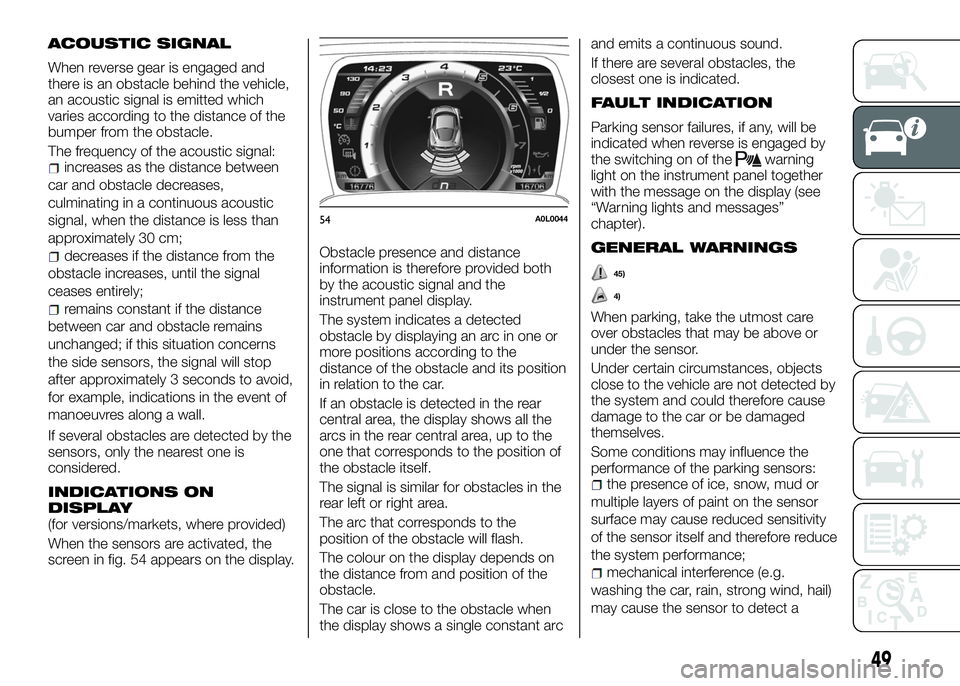
ACOUSTIC SIGNAL
When reverse gear is engaged and
there is an obstacle behind the vehicle,
an acoustic signal is emitted which
varies according to the distance of the
bumper from the obstacle.
The frequency of the acoustic signal:
increases as the distance between
car and obstacle decreases,
culminating in a continuous acoustic
signal, when the distance is less than
approximately 30 cm;
decreases if the distance from the
obstacle increases, until the signal
ceases entirely;
remains constant if the distance
between car and obstacle remains
unchanged; if this situation concerns
the side sensors, the signal will stop
after approximately 3 seconds to avoid,
for example, indications in the event of
manoeuvres along a wall.
If several obstacles are detected by the
sensors, only the nearest one is
considered.
INDICATIONS ON
DISPLAY
(for versions/markets, where provided)
When the sensors are activated, the
screen in fig. 54 appears on the display.Obstacle presence and distance
information is therefore provided both
by the acoustic signal and the
instrument panel display.
The system indicates a detected
obstacle by displaying an arc in one or
more positions according to the
distance of the obstacle and its position
in relation to the car.
If an obstacle is detected in the rear
central area, the display shows all the
arcs in the rear central area, up to the
one that corresponds to the position of
the obstacle itself.
The signal is similar for obstacles in the
rear left or right area.
The arc that corresponds to the
position of the obstacle will flash.
The colour on the display depends on
the distance from and position of the
obstacle.
The car is close to the obstacle when
the display shows a single constant arcand emits a continuous sound.
If there are several obstacles, the
closest one is indicated.
FAULT INDICATION
Parking sensor failures, if any, will be
indicated when reverse is engaged by
the switching on of the
warning
light on the instrument panel together
with the message on the display (see
“Warning lights and messages”
chapter).
GENERAL WARNINGS
45)
4)
When parking, take the utmost care
over obstacles that may be above or
under the sensor.
Under certain circumstances, objects
close to the vehicle are not detected by
the system and could therefore cause
damage to the car or be damaged
themselves.
Some conditions may influence the
performance of the parking sensors:
the presence of ice, snow, mud or
multiple layers of paint on the sensor
surface may cause reduced sensitivity
of the sensor itself and therefore reduce
the system performance;
mechanical interference (e.g.
washing the car, rain, strong wind, hail)
may cause the sensor to detect a
54A0L0044
49
Page 54 of 182
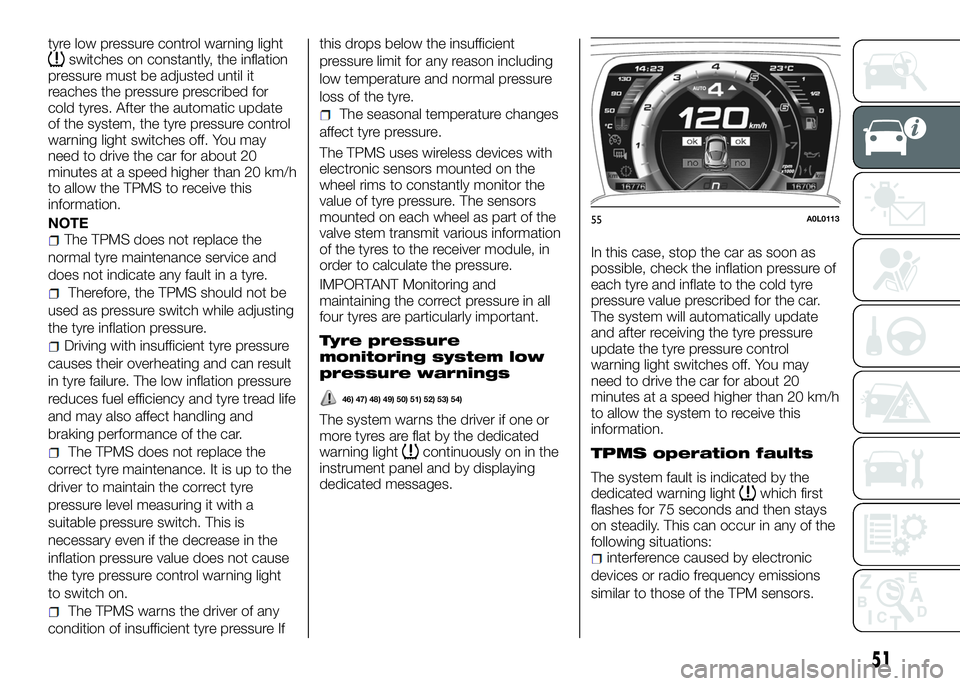
tyre low pressure control warning lightswitches on constantly, the inflation
pressure must be adjusted until it
reaches the pressure prescribed for
cold tyres. After the automatic update
of the system, the tyre pressure control
warning light switches off. You may
need to drive the car for about 20
minutes at a speed higher than 20 km/h
to allow the TPMS to receive this
information.
NOTE
The TPMS does not replace the
normal tyre maintenance service and
does not indicate any fault in a tyre.
Therefore, the TPMS should not be
used as pressure switch while adjusting
the tyre inflation pressure.
Driving with insufficient tyre pressure
causes their overheating and can result
in tyre failure. The low inflation pressure
reduces fuel efficiency and tyre tread life
and may also affect handling and
braking performance of the car.
The TPMS does not replace the
correct tyre maintenance. It is up to the
driver to maintain the correct tyre
pressure level measuring it with a
suitable pressure switch. This is
necessary even if the decrease in the
inflation pressure value does not cause
the tyre pressure control warning light
to switch on.
The TPMS warns the driver of any
condition of insufficient tyre pressure Ifthis drops below the insufficient
pressure limit for any reason including
low temperature and normal pressure
loss of the tyre.
The seasonal temperature changes
affect tyre pressure.
The TPMS uses wireless devices with
electronic sensors mounted on the
wheel rims to constantly monitor the
value of tyre pressure. The sensors
mounted on each wheel as part of the
valve stem transmit various information
of the tyres to the receiver module, in
order to calculate the pressure.
IMPORTANT Monitoring and
maintaining the correct pressure in all
four tyres are particularly important.
Tyre pressure
monitoring system low
pressure warnings
46) 47) 48) 49) 50) 51) 52) 53) 54)
The system warns the driver if one or
more tyres are flat by the dedicated
warning light
continuously on in the
instrument panel and by displaying
dedicated messages.In this case, stop the car as soon as
possible, check the inflation pressure of
each tyre and inflate to the cold tyre
pressure value prescribed for the car.
The system will automatically update
and after receiving the tyre pressure
update the tyre pressure control
warning light switches off. You may
need to drive the car for about 20
minutes at a speed higher than 20 km/h
to allow the system to receive this
information.TPMS operation faults
The system fault is indicated by the
dedicated warning lightwhich first
flashes for 75 seconds and then stays
on steadily. This can occur in any of the
following situations:
interference caused by electronic
devices or radio frequency emissions
similar to those of the TPM sensors.
55A0L0113
51
Page 56 of 182

In order to use the system properly, refer to the following table when you have to change wheels/tyres:
OperationSensors on wheels fitted on
carFailure indication Action necessary
– – YESContact a dedicated Alfa Romeo
Dealership
Wheel change with winter tyres NO YESContact a dedicated Alfa Romeo
Dealership
Wheel change with winter tyres YES NO –
Wheel change with others of a
different size
(*)YES NO –
(*)Given as an alternative in the Owner Handbook as well as in the Registration Document; available from Lineaccessori Alfa Romeo.
WARNING
46)The presence of the TPMS does not
permit the driver to neglect regular checks
of the tyre pressure, including for the spare
wheel.
47)Tyre pressure must be checked with
tyres rested and cold. Should it become
necessary for whatever reason to check
pressure with warm tyres, do not reduce
pressure even though it is higher than the
prescribed value. Repeat the check when
the tyres are cold.
48)Should one or more wheels be fitted
without sensors, the system will no longer
be available and, in addition to the TPMS
warning light flashing for less than one
minute before becoming constant, a
warning message will be shown on the
display, until four wheels with sensors are
fitted again.49)The TPMS cannot warn of sudden
decreases in tyre pressure (for example
when a tyre bursts). In this case, stop the
car, braking with caution and avoiding
abrupt steering.
50)Replacing standard tyres with winter
tyres (and vice versa) requires TPMS
adjustment that must only be performed by
a dedicated Alfa Romeo Dealership.
51)Changes in outside temperature may
cause tyre pressures to vary. The TPMS
system may temporarily indicate insufficient
pressure. In this case, check the tyre
pressure when cold and, if necessary,
restore the inflation values.52)When a tyre is removed, it is advisable
to replace the rubber valve seal as well:
contact a dedicated Alfa Romeo
Dealership. Tyre and/or rim fitting/removal
operations require specific precautions; to
avoid damaging or fitting the sensors
incorrectly, tyre and/or rim fitting/removal
operations should only be carried out by
specialised staff. Contact a dedicated Alfa
Romeo Dealership.
53)Intense radio-frequency interference
may prevent the correct operation of the
TPMS. This condition will be indicated by a
message on the display. The message will
disappear automatically as soon as the
radio-frequency interference ceases to
affect the system.
53